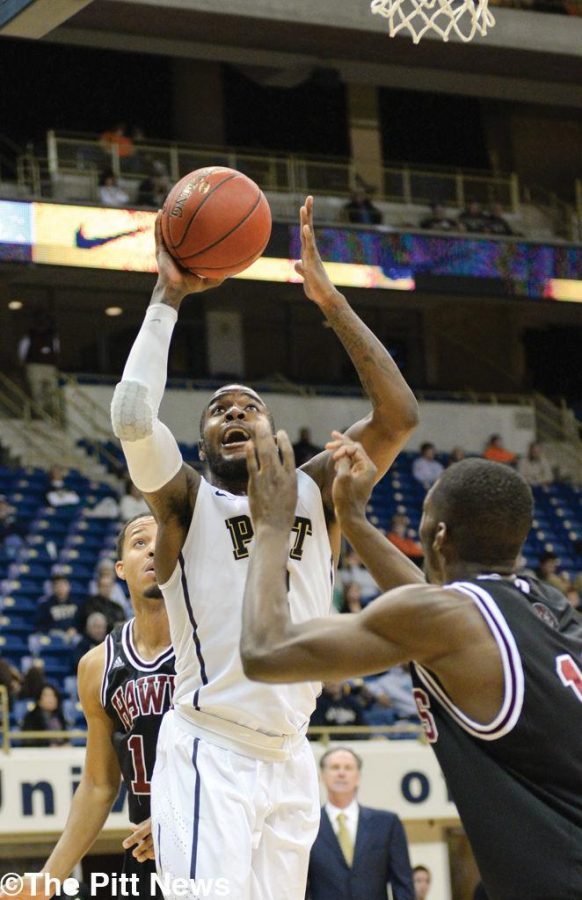Taking charge: Mike Young taking leadership role for Pitt
November 2, 2014
During the summer of 2013, the Pitt men’s basketball team faced a glaring hole at the center position after losing three key players. Steven Adams went to the NBA, reserve center Dante Taylor graduated and third-stringer Malcolm Gilbert transferred to Fairfield.
But head coach Jamie Dixon didn’t fret. He used an internal option and converted then-power forward Talib Zanna, who started for Dixon as a junior in 2012-13, to a center for the upcoming season.
The decision was unpopular at first. Many pundits told Dixon that Zanna couldn’t do it. But Zanna ended up finishing the season as the ACC’s co-leader in rebounding, and the 6-foot-9 Nigeria native was also named to the conference’s all-tournament team.
Zanna is now pursuing a career in the NBA, and Dixon must find a new center. Dixon has three pure centers on his current roster, but another power forward-to-center conversion is taking place. This time, it’s with sophomore Michael Young, who, last season, became the fourth Pitt basketball player to start as a freshman in a decade.
With Cameron Wright recovering from a broken left foot and Durand Johnson slowly progressing after tearing his ACL last season, Young started at power forward in Pitt’s first exhibition game on Oct. 31. After the game, Dixon classified his lineup as a work in progress. He will likely shuffle it when Wright and Johnson are back to form, but all signs point to Young starting at center.
Each November, Pitt fans arrive at the Petersen Events Center for the Panthers’ home opener unaware of the starting lineup Dixon will send to the floor for tipoff. But, since midsummer, Dixon has hinted that he will include Young in the starting five.
At Pitt’s October media day, Dixon said Young brings an added dimension to the five that he hasn’t seen in 12 years as Pitt’s coach.
“He gives a little more versatility that we’ve never had,” Dixon said. “We never really had a guy with that skill who can play the five. But he was our best post defender last year, and so that’s encouraging to me that we’re not going to lose anything defensively if we play him at that spot.
“And I don’t know that [Young] has the same knack [as Zanna] for going after the basketball, but he’s going to create some challenges offensively for the defense,” Dixon added.
Young said his teammates call him “Mr. Do Everything.” He came to Pitt last year as a raw 6-foot-8, 245-pounder. Since athletes generally put on weight when they undergo moves to more contact-demanding positions, one might find it hard to believe that while Young grew an inch and a half in the past year, he’s actually lost 15 pounds since the Panthers’ second-round NCAA Tournament exit in March.
Young was by no means overweight last year, but the Duquesne native claims he lacked the strength to support his towering frame. This, Young said, was a reason for why he partially fractured his back mid-season.
“[It was an] over-time thing. It was kind of like a pipe busting due to pressure,” he said. “It wasn’t due to the weight, but losing weight would have helped.”
Young started all 36 games for the Panthers last season despite the injuries. Dixon said he nearly started Jamel Artis over the banged-up Young in Pitt’s March 1 game at Notre Dame, but Young battled through the discomfort. In 30 minutes of action that afternoon against the Irish, Young contributed 13 points and three rebounds in Pitt’s 85-81 overtime win.
Young used two of his fingers to describe the injury in detail, which the team quietly labeled as a “lower back injury” throughout last winter.
“It wasn’t a clear fracture,” Young said. “It was just a little bone in my lower back. If this were my bone, I fractured it like halfway through, so it didn’t completely fracture. If it would have completely fractured, they would’ve put a little screw in there. But, because it didn’t completely fracture, they just let it heal on its own.”
While recovering from the injury, Young took many steps in improving his overall well-being. He has added muscle to his legs, and he spends more time stretching. He even added hot yoga to his summer workout routine.
Pitt basketball’s strength and conditioning coach Tim Beltz worked with Young during the recovery process, and the two worked during the offseason to create a more appropriate body type for Young.
“With basketball players, that’s what’s going to help them be the most successful and durable,” Beltz said. “The biggest, heaviest guys don’t win in this game. You’ve got to be long, lean and athletic to play at a higher level. And to play at our level, and to play post-college, your body has got to be of utmost importance.”
Beltz added that it’s not just about weight.
“It’s about preparing our bodies, making sure they’re elastic and explosive,” he said. “We don’t just want somebody that can jump 45 inches one time in a vertical leap. We want somebody that can repeat a high-level effort consistently.”
With Pitt’s depth at center, Dixon confirmed that Young will also get time at power forward. Young claims that his fine-tuned body is now capable of matching up against anyone on the floor, but said he’s most comfortable playing center.
And with heavy emphasis on the words “one time,” Dixon summed up Young’s status with an utterance that fans annually ring through the Petersen Events Center’s air every senior day.
“I would like to get through the year healthy one time and see how we can go with the group we started with,” Dixon said. “We’ll see how it goes.”



